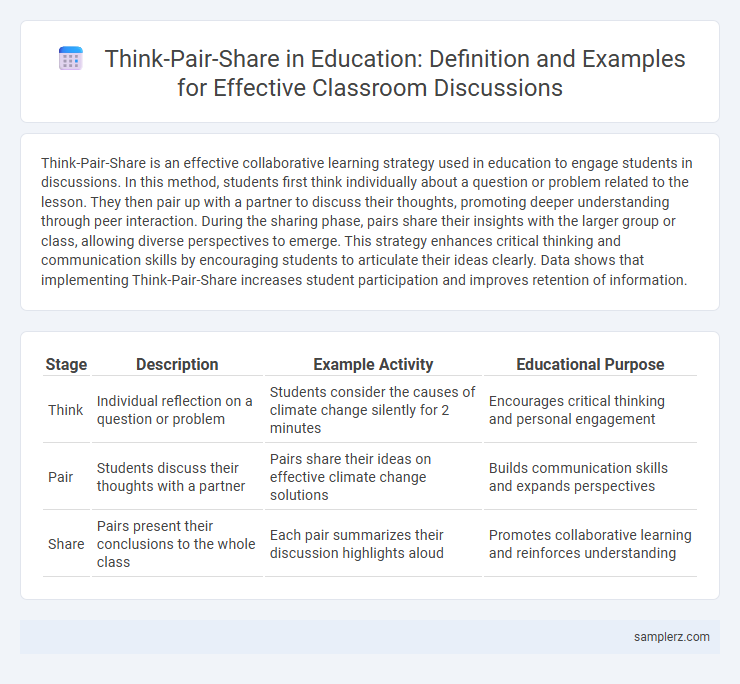Think-Pair-Share is an effective collaborative learning strategy used in education to engage students in discussions. In this method, students first think individually about a question or problem related to the lesson. They then pair up with a partner to discuss their thoughts, promoting deeper understanding through peer interaction. During the sharing phase, pairs share their insights with the larger group or class, allowing diverse perspectives to emerge. This strategy enhances critical thinking and communication skills by encouraging students to articulate their ideas clearly. Data shows that implementing Think-Pair-Share increases student participation and improves retention of information.
Table of Comparison
| Stage | Description | Example Activity | Educational Purpose |
|---|---|---|---|
| Think | Individual reflection on a question or problem | Students consider the causes of climate change silently for 2 minutes | Encourages critical thinking and personal engagement |
| Pair | Students discuss their thoughts with a partner | Pairs share their ideas on effective climate change solutions | Builds communication skills and expands perspectives |
| Share | Pairs present their conclusions to the whole class | Each pair summarizes their discussion highlights aloud | Promotes collaborative learning and reinforces understanding |
Introduction to Think-Pair-Share in Class Discussions
Think-Pair-Share is an interactive teaching strategy that promotes active student engagement by encouraging individual thinking followed by collaborative discussion. Students first contemplate a question independently, then pair up to exchange ideas, fostering deeper understanding through peer interaction. This method enhances critical thinking skills and ensures inclusive participation in class discussions.
How Think-Pair-Share Enhances Student Engagement
Think-Pair-Share enhances student engagement by encouraging active participation and collaboration through structured dialogue. This technique prompts individual thinking, followed by paired discussion, which deepens understanding and builds communication skills. Research shows that students involved in Think-Pair-Share activities demonstrate improved critical thinking and increased motivation to contribute in class discussions.
Step-by-Step Example of Think-Pair-Share in Action
Think-Pair-Share begins with the teacher posing a thought-provoking question about a specific topic, such as the causes of climate change. Students first think individually about their responses for two minutes, then pair up to discuss their ideas collaboratively, encouraging deeper understanding and diverse perspectives. Finally, pairs share their conclusions with the larger class, facilitating a comprehensive group discussion and reinforcing critical thinking skills.
Designing Effective Think-Pair-Share Prompts
Designing effective Think-Pair-Share prompts requires crafting clear, open-ended questions that stimulate critical thinking and invite diverse perspectives. Prompts should challenge students to analyze concepts, justify opinions, and connect ideas to real-world contexts. Using scenario-based questions or problem-solving tasks enhances engagement and deepens understanding during the paired and shared phases of discussion.
Real-World Classroom Scenarios Using Think-Pair-Share
In a middle school science class, students first contemplate a question about climate change individually, then pair up to discuss their ideas and evidence, enhancing critical thinking and collaborative skills. During a history lesson on ancient civilizations, learners share insights with a partner before presenting their conclusions to the wider group, fostering deeper understanding and communication. In a literature class, think-pair-share helps students analyze themes in a novel by encouraging personal reflection, peer discussion, and collective dialogue, promoting active engagement and diverse perspectives.
Strategies for Facilitating Think-Pair-Share Discussions
In think-pair-share discussions, educators enhance student engagement by first posing a clear, thought-provoking question to stimulate individual thinking. Next, learners pair up to exchange ideas, ensuring active participation and deeper understanding through peer collaboration. Finally, sharing insights with the larger group consolidates knowledge and promotes critical thinking skills across diverse classroom settings.
Benefits of Think-Pair-Share for Diverse Learners
Think-Pair-Share enhances engagement by allowing diverse learners to process information individually before articulating thoughts with peers, promoting deeper understanding. It boosts confidence among shy or English language learners by providing a structured platform for verbal interaction. Collaborative dialogue fosters inclusivity and supports varied learning styles, improving critical thinking and communication skills across diverse classrooms.
Overcoming Challenges in Implementing Think-Pair-Share
Teachers face obstacles such as limited classroom time and varying student participation when implementing Think-Pair-Share in discussions. Strategies like setting clear time limits, providing sentence starters, and creating an inclusive environment help overcome these challenges. Research shows that scaffolding and consistent practice improve student engagement and the effectiveness of Think-Pair-Share activities.
Assessment Techniques for Think-Pair-Share Activities
Think-Pair-Share assessment techniques include formative assessments such as real-time observations and immediate feedback during student discussions. Teachers can use rubrics to evaluate the quality of student responses, collaboration skills, and critical thinking demonstrated in pairs before sharing with the whole class. Peer assessment also enhances accountability and encourages deeper reflection on the content exchanged during the think-pair-share activity.
Reflecting on Think-Pair-Share: Student and Teacher Perspectives
Think-Pair-Share encourages active reflection by prompting students to first process information individually, then engage in collaborative dialogue with peers before sharing insights with the larger group. Teachers observe that this strategy enhances critical thinking and communication skills while fostering deeper understanding through diverse viewpoints. Student feedback highlights increased confidence and clarity in expressing ideas, resulting in more meaningful classroom discussions.

example of think-pair-share in discussion Infographic
 samplerz.com
samplerz.com